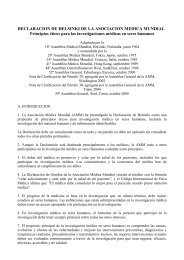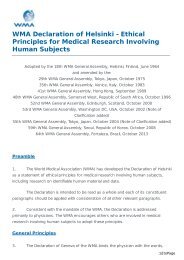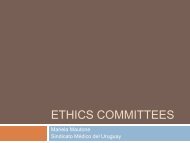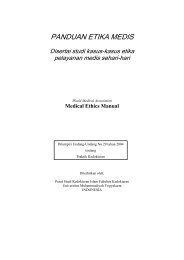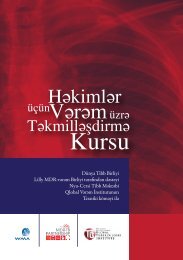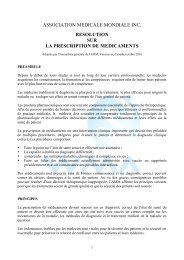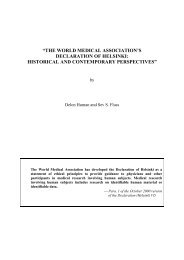WMJ 03 2010 - World Medical Association
WMJ 03 2010 - World Medical Association
WMJ 03 2010 - World Medical Association
- No tags were found...
Create successful ePaper yourself
Turn your PDF publications into a flip-book with our unique Google optimized e-Paper software.
Regional and NMA news<br />
These 1547 patients are distributed by country<br />
as follows:<br />
• Benin: 217 cases<br />
• Burkina Faso: 182 cases<br />
• Côte d’Ivoire: 29 cases<br />
• Guinea Bissau: 747 cases<br />
• Mali: 108 cases<br />
• Niger: 2<strong>03</strong> cases<br />
• Senegal: 28 cases<br />
• Togo: 3 cases<br />
Participants of Burkina Faso and Côte d’Ivoire surrounding the Head of the Department of Social<br />
and Cultural Development (March <strong>2010</strong>)<br />
General objective<br />
The general objective of the recent dialogue<br />
was to identify and evaluate the specialized<br />
care facilities in each country that could<br />
function as regional centers of excellence in<br />
order to reduce the medical evacuations out<br />
of UEMOA space. These evaluations were<br />
made by a competent authority 1 under the<br />
supervision of an international expert 2 .<br />
Results<br />
The total number of evacuations made by<br />
each country’s Council of Health during<br />
the years 2007 and 2008 is 1547 patients for<br />
the eight countries of the UEMOA.<br />
The evacuations organized by category are<br />
as follows:<br />
• Cardiovascular system: 305 cases (22.6%)<br />
• Musculoskeletal system: 245 cases (16%)<br />
• Urinary tract: 237 cases (15.3%)<br />
• Nervous system: 151 cases (10%)<br />
• Ocular system: 142 cases (9%)<br />
• Gynecological system: 133 cases (8.6%)<br />
Pathologies of these six systems account for<br />
81% of the medical reasons for evacuations.<br />
Among six countries (excluding Togo,<br />
whose Council of Health did not sit and<br />
consequently did not evacuate any patient<br />
during the period, and Guinea Bissau), 767<br />
patients were evacuated by the Councils of<br />
Health out of the region in 2007 and 2008.<br />
The case of Guinea Bissau is to be taken<br />
separately because it evacuated nearly as<br />
many patients as all of the other UEMOA<br />
countries combined. Its 747 cases were evacuated<br />
principally due to urinary pathologies<br />
(e.g., urolithiasis, hydronephrosis), which<br />
are dealt with successfully in almost all the<br />
UEMOA countries.<br />
Among the pathologies listed for the evacuations,<br />
most frequent are:<br />
• cardiovascular: congenital cardiopathies,<br />
valvular diseases, auriculo-ventricular<br />
block<br />
• musculoskeletal system: osteoarthritis of<br />
the hip and arthrosis of the knee<br />
• cancerology (radiotherapy): uterine collar<br />
and breast cancer<br />
• nervous system: encephalic tumour, meningioma,<br />
slipped disc<br />
• ophthalmology: retinopathy repair, lesion<br />
of glazed, glaucoma<br />
Reasons given for evacuations are as follows:<br />
• insufficient materials<br />
• insufficient human resources<br />
• political or administrative pressure<br />
• the kindness of the doctors<br />
• insufficient hygiene in local health facilities<br />
Participants of the Ouagadougou UEMOA meeting (March <strong>2010</strong>)<br />
115



